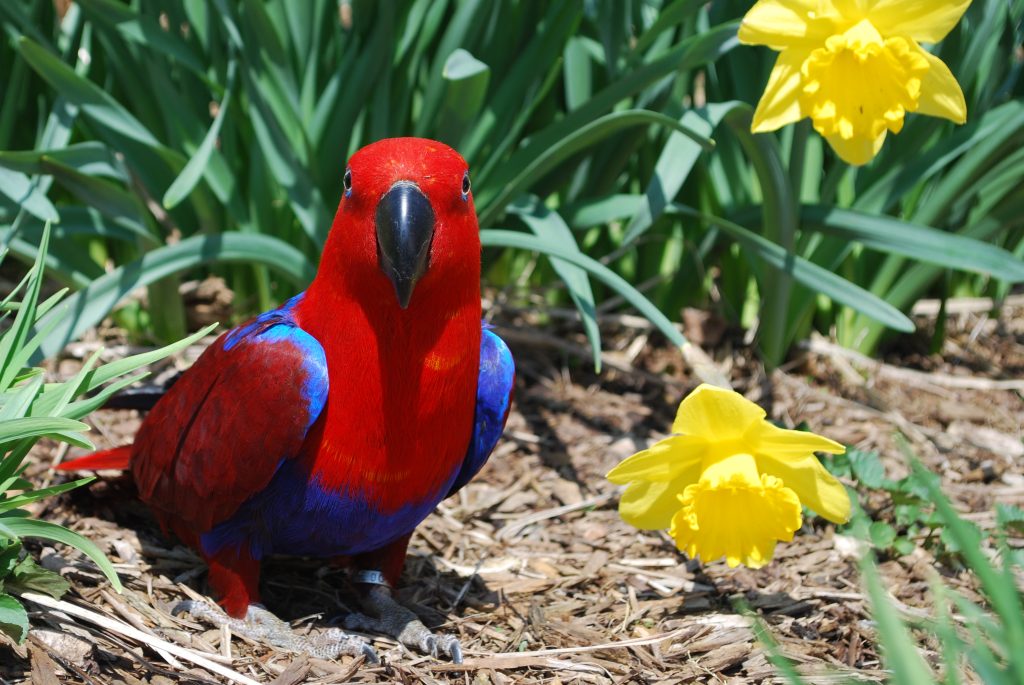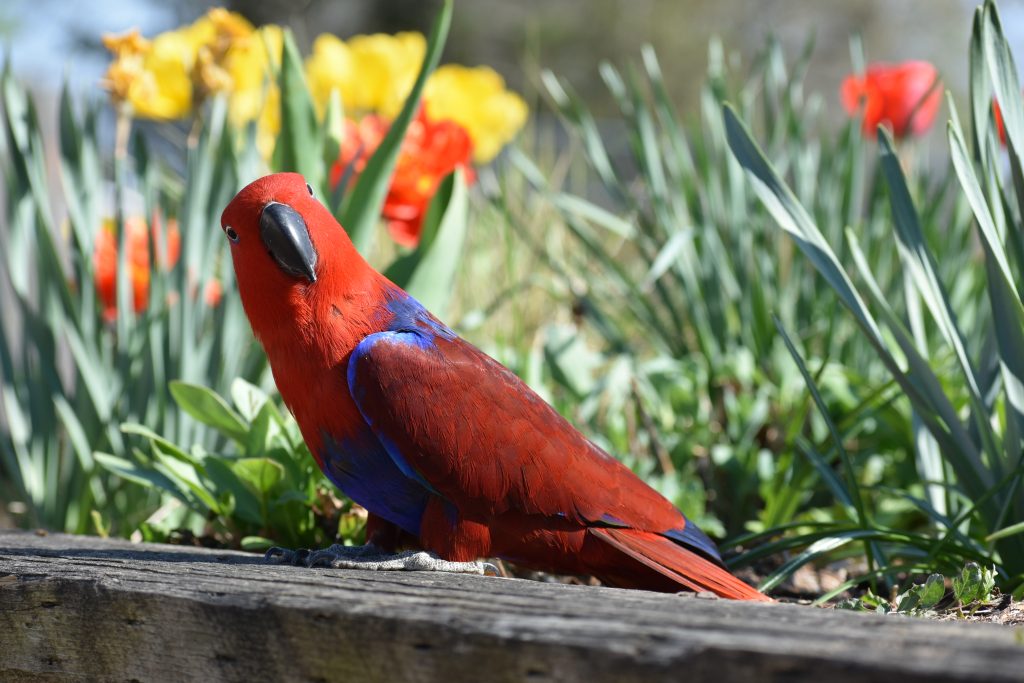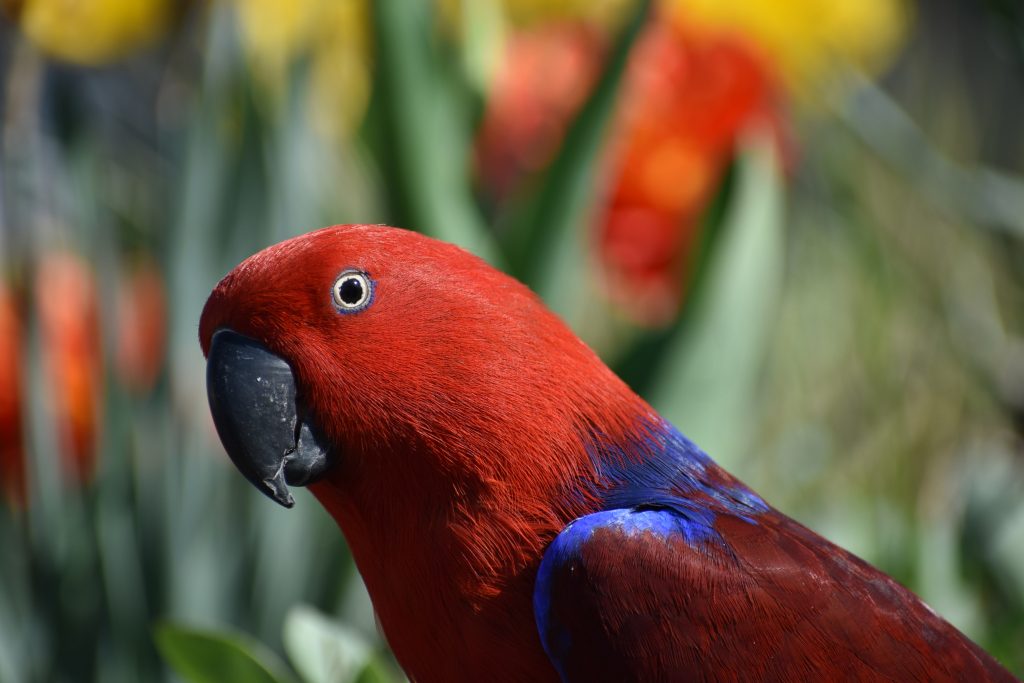Eclectus roratus | Eclectus
Name: Zelda (Female)



Meet Zelda, the Radiant Eclectus Parrot
Colorful. Charismatic. Clever. Zelda is our stunning female Eclectus parrot, and she’s here to challenge everything you thought you knew about bird coloration! Unlike most species, male and female Eclectus parrots look so different that early scientists once believed they were two separate species.
Males are a leafy green with bright orange beaks, blending in seamlessly with the rainforest canopy as they forage. Females, like Zelda, sport a vibrant red and royal blue plumage with striking black beaks—perfect for standing out and guarding their nest. This stark difference in appearance between the sexes is called sexual dimorphism, and in the Eclectus world, it’s both beautiful and practical.
Rainforest Royalty
Eclectus parrots are native to the lush lowland rainforests of the Solomon Islands, New Guinea, the Maluku Islands, and northeastern Australia. They prefer the middle to upper levels of the forest canopy, where sunlight filters through the leaves and fruiting trees offer a rich, plant-based diet.
As herbivores, Eclectus parrots eat a variety of fruits, wild figs, flower and leaf buds, nectar, and unripe nuts. Their hooked beaks are perfectly suited for prying open tough shells and digging into juicy pulp. In their natural habitat, they play a critical role as seed dispersers, helping maintain the health and growth of the rainforest.
Here at the zoo, Zelda enjoys a similar menu—including Mazuri parrot chow, fresh produce, seeds, and nuts. But don’t bother offering her dandelions—she’s made it clear they’re not on her list of favorites!
Cavity Nester with Class
Like all Eclectus parrots, Zelda is a cavity nester, meaning she would build her nest inside a hollow tree. In the wild, a female will find and defend a nest site—often long before she’s ready to lay eggs. Once she’s claimed it, she may keep it for months at a time, especially if it’s in a resource-rich area.
Eclectus parrots are primarily polyandrous, with females often mating with multiple males. In some populations, they may also be polygynandrous, meaning both males and females have multiple partners. During breeding season, cooperative breeding behaviors emerge while the female incubates the eggs, multiple males may bring her food and provide protection.
Once the chicks hatch, they remain in the nest for about three months. After fledging, the male parrots take on most of the care, and the young are usually independent by six months of age.
Social Butterflies with Something to Say
Eclectus parrots are intelligent, highly social birds. They often live in small flocks or lose associations with others. While they may occasionally be seen alone or in pairs, they thrive best with social interaction.
They communicate with a variety of whistles, squawks, and clicks—and each bird has a voice as unique as their feathers. Zelda is no exception. When she’s content, she makes soft cooing or slurping noises that let us know she’s happy and relaxed.
Why Zelda Isn’t a Pet (and Shouldn’t Be)
Zelda might seem like the perfect pet—she’s gorgeous, intelligent, and full of personality—but Eclectus parrots are not suitable pets for most people. Here’s why:
- Long Lifespan: These parrots can live over 40 years, requiring a lifetime of commitment.
- High Social Needs: Without enough mental stimulation and interaction, Eclectus parrots can develop behavioral issues like feather plucking.
- Space Requirements: They need large, vertical spaces to move and fly—something most homes can’t offer.
- Cost of Care: Proper diet, specialized veterinary care, and enrichment come with a high price tag.
Sadly, many parrots are surrendered to rescues or live in unsuitable conditions when their care becomes too much. Want to learn more about why domestic animals make better companions for most people? Check out the Not-a-Pet campaign!
Fact Sheet
Taxonomy
Genus: Eclectus | Species: roratus
Kingdom: Animalia | Phylum: Chordata | Class: Aves | Order: Psittaciformes | Family: Psittacidae |
Favorite Enrichment Type
Anything that she can nest in!
What I Sound Like
Life Span
- In the Wild: 40 to 50+ years
- In Human Care: 30 to 40+ years
Diet
- In the Wild: Fruits, wild figs, unripe nuts, and flower/leaf buds, blossoms, and nectar
- At the Zoo: Mazuri® parrot chow, fresh produce, and a variety of seeds and nuts
Geographic Range
Soloman Islands, Sumba, New Guinea, Maluku Islands, Northeastern Australia.
Habitat
Lowland rainforest canopies.
Fun Facts About Eclectus Parrots
- Sexual dimorphism: Males and females look so different, early researchers thought they were separate species!
- Brush-tipped tongues: Perfect for slurping up nectar and soft fruits.
- Long lifespans: These parrots can live 40–50 years or more in the wild.
- Color with purpose: Bright red females stand out to defend nests, while green males blend in while foraging.
- Excellent mimics: With enough socialization, they can imitate words and household sounds.
- Cooperative breeders: Multiple males often assist one female with feeding and protection during nesting season.
Status: Least Concern
Support Conservation and Responsible Bird Care
Zelda reminds us that wild birds belong in the wild—or in expert care settings, not in our living rooms. If you’d like to support parrots like Zelda, consider:
- Visiting AZA-accredited zoos and aquariums that provide proper care and enrichment.
- Donating to reputable bird rescues and sanctuaries.
- Saying NO to the illegal wildlife trade.
- Adopting, not shopping for feathered companions—and choosing species that fit your lifestyle and resources.
- There are many parrots, like Zelda, waiting in rescues for someone prepared to meet their needs.
How to Find Me
Looking to meet Zelda? Head on over to our Aviary, nestled between our Outback viewing deck and the white-throated capuchin habitat. You can find her in one of the side habitats, viewable from the outback viewing deck!
